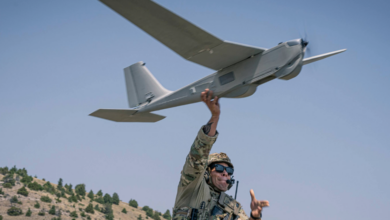Flapless flight: Successful first flight of ground-breaking BAE Systems MAGMA UAV
BAE Systems and University of Manchester research could change the future of aircraft design with unique blown-air flight control technology
BAE Systems and the University of Manchester successfully completed the first phase of flight trials of MAGMA, a new unmanned aerial vehicle with a revolutionary flight control system.
The small-scale drone uses a unique blown-air system to manoeuvre, potentially paving the way for future stealthier aircraft.
The new control concept removes the mechanical moving parts conventionally used to control aircraft during flight. The system could give greater control as well as a reduction in weight and mechanical maintenance, and enable lighter, faster, stealthier and more efficient future aircraft designs.
Two technologies are being trialled in the jet-powered UAV – Wing Circulation Control, which takes air from the aircraft engine and blows it supersonically through the trailing edge of the wing to provide control; and Fluidic Thrust Vectoring, which uses blown air to deflect the jet exhaust, giving directional control.
Further flight trials are planned, with the ultimate aim of flying the aircraft without any moving control surfaces or fins, which would be the first ever use of such a control system on a gas turbine aircraft in flight, and from a single engine.
“These trials are an important step forward in our efforts to explore adaptable airframes. What we are seeking to do through this programme is truly ground-breaking,” said Bill Crowther, a senior academic and leader of the MAGMA project at The University of Manchester.
BAE Systems’ Lead Technologist, Advanced Structures Brian Oldfield told The Defense Post that the main function of the blown air is to “provide the air for flow control devices which will replace mechanical moving control surfaces.”
“The blown air is hot because of where it is taken off the engine, so it is not being used to change the IR stealthiness of the aircraft,” Oldfield said.
“MAGMA is a 4m wingspan vehicle weighing 40kg in its conventional control state and is a low speed vehicle for demonstrating novel technology,” Oldfield said, adding that when modified with novel flow-control devices it will weigh 45kg.
Oldfield said that some aspects of the new technology are scaleable, and applicable to fighters or commercial vehicles. “Part of the research is to understand these issues and establish the benefits of the technology for these kinds of vehicles,” he said.
The flight trials are part of an ongoing project between BAE Systems and the University of Manchester to develop innovative flight control technology, and form part of a wider long-term collaboration involving industry, academia and government.
“The technologies we are developing with the University of Manchester will make it possible to design cheaper, higher performance, next generation aircraft,” Clyde Warsop, Engineering Fellow at BAE Systems said.
BAE says technologies to improve MAGMA’s performance are being explored in collaboration with the University of Arizona and the NATO Science and Technology Organisation.
BAE Systems has invested £4.4 billion in research and development over the past five years, including £1 billion in 2016 alone. The company has invested £10.7 million partnering with U.K. universities in areas such as novel materials, advanced manufacturing, artificial intelligence, air vehicles and avionics.













